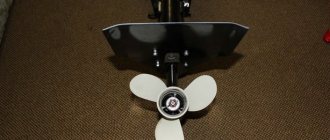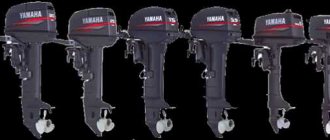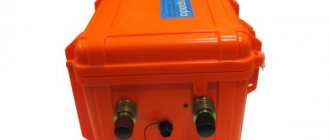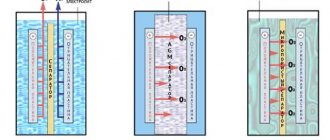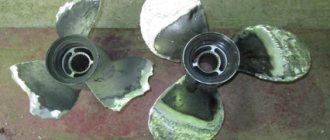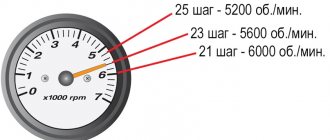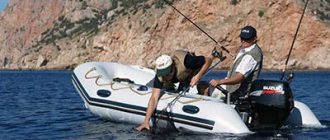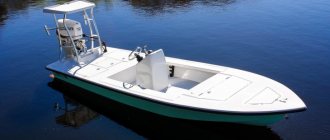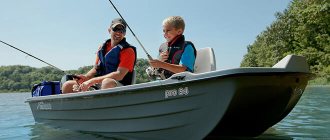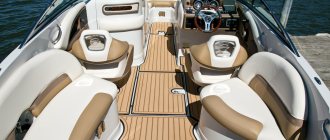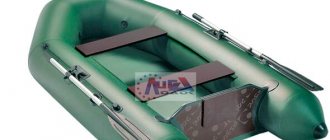What are homemade boat motors made from?
Some products will be suitable, even faulty ones, but on one condition that their motor is working. Even if you buy a new gas mower or screwdriver, it will turn out to be much cheaper than a new outboard motor; all that remains is to modify the product a little. The financial issue turns out to be the main one in solving this problem, otherwise every boat would already have a motor.
- To make a boat motor with an electric drive, you will have to purchase a screwdriver or a battery-powered electric drill. It is possible that someone has a damaged screwdriver or drill lying around in their barn or garage. It is preferable to use a screwdriver, since its output speed is not so high.
- Naturally, those batteries that are installed on electrical appliances are not powerful enough to move around a body of water for a long time. In this case, a 12 V car battery is suitable. Naturally, devices must be purchased for the same operating voltage. The power of an electrical device of 300 W is enough for the boat to move around a pond with a load.
- The problem of reducing the speed of the electrical appliance must also be solved. In this case, you will need a gearbox. This is especially true when using an electric drill.
- You will also have to make or buy a drive shaft and propeller. The advantage of an electric boat motor is that it operates silently. In addition, repairing such a motor will cost much less than repairing a classic outboard motor.
- Gasoline engines are much more powerful, so they can significantly increase the fishing area. In addition, their power does not decrease, like with electric motors, and the battery has significant weight and takes up useful space. You can use power units from brush cutters, walk-behind tractors, chainsaws, etc. You should choose based on your financial capabilities, the size of the boat, as well as what device is available.
- Trimmers are most suitable for such purposes, since they require minimal modifications. It is enough to replace the device where the fishing line is attached and install the propeller, and the motor is ready and can be used.
- Other power devices require more serious modifications, since they require a gearbox, shaft and propeller. In addition, they need to be connected together.
On a note! Some fishermen use a motorized cultivator by removing the cutters and installing primitive rowing blades in their place.
In addition to making the motor, you should think about how to mount it on the boat. The fact is that not every boat has a transom and not every boat is suitable for installing a motor. It is especially difficult to install such a device on a rubber inflatable boat.
Boat motor from a screwdriver
Screwdrivers are best for making boat motors. You should choose a device with an operating voltage of 12 V so that you can install a car battery with a capacity of 45-55 ampere-hours. The device is being finalized in an elementary way.
Cordless outboard motor based on METABO BS 18 LT 5.2 Ah screwdriver
Lifting mechanism
The task of the lifting mechanism is to move the motor in various planes, both horizontal and vertical, in order not only to control the craft, but also to be able to lift the engine out of the water. The simplest design is a system of clamps with which the screwdriver is attached to the lifting mechanism. The lifting mechanism must be rigidly attached to the boat, especially if the boat is rubber. The clamps must have rings through which the tube passes, and inside the tube there is a shaft made of a steel rod of suitable diameter. To make sliding easy, bearings are installed inside the tube.
Gearbox and propeller
The screwdriver develops high speeds, but this is not necessary for a homemade electric motor for a boat, so a gearbox is needed. A gearbox from an angle grinder is the most suitable option. To attach the gearbox, the upper part of its shaft is simply clamped in the screwdriver chuck.
You will also need a propeller, which is best made of stainless steel, 2.5-3.0 mm thick. Do not use aluminum or plastic.
Procedure:
- First of all, a square blank measuring 30x30 cm is cut out.
- A square measuring 5x5 cm is marked in the center of the workpiece and diagonal lines are drawn through the corners. Along these lines you need to cut the workpiece to a small square.
- The 4 resulting petals are rounded and rotated at an angle of 30 degrees.
- In the center of the product you need to drill a hole for mounting on the gearbox.
- After this, the propeller is installed in its place and securely fastened.
Propeller for screwdriver 2. Boat motor from screwdriver
HOMEMADE BOAT MOTORS (Continued - started in No. 5/2018)
In the previous article, we looked at the lightest “hybrid” outboard motors, made on the basis of the Soviet “Salyut” with trimmer motor heads. In terms of their weight and size characteristics, they are unrivaled, but they also have a number of serious disadvantages, such as high noise, high fuel consumption for their power, and unstable operation at low speeds.
RUNNING TESTS OF LAWN MOWERS
Four-stroke engines with a vertical shaft, the so-called “lawn mowers,” do not have the disadvantages listed above. Therefore, if you look at people’s experiences on the Internet, it becomes obvious why they most often attract do-it-yourselfers, who especially like about half the fuel consumption of classic two-stroke engines of the same power.
Most four-stroke “lawnmower” internal combustion engines, like trimmer engines, have a similar design - one air-cooled cylinder with an impeller on the flywheel, lubrication of moving parts by splashing oil poured into the crankcase, a gas distribution mechanism with a rod valve drive (the so-called OHV scheme), the same type of simple carburetors with a float chamber, a simple and reliable electronic ignition system with a fixed ignition timing, throttle control via a centrifugal speed controller designed for a maximum of 3600 rpm.
Many engines have a decompressor - a simple mechanism that slightly opens the exhaust valve at low speeds and thereby greatly facilitates starting. In general, we can say that all Chinese engines of this type approximately reproduce the previous generation Honda, which is similar in parameters.
A special place among “lawn mowers” is occupied by engines from the American company Briggs and Stratton, although they are now produced anywhere but in the USA. Many of them have an extremely archaic lower valve timing system, which automakers abandoned back in the 1940s. However, for low-speed engines such a scheme has a right to exist, since it provides a more “dense” layout and, accordingly, small dimensions.
On the contrary, the engines of the Japanese companies Honda and Robin-Subaru are distinguished by a high-tech circuit with a camshaft in the cylinder head (the so-called ONC circuit); accordingly, they can be “spinned” to a frequency above 4000 rpm. But the price of the “Japanese” is approximately three times higher than the “Chinese”; they are also twice as expensive as Briggs and Stratton engines with similar parameters.
Most companies do not publish the external speed characteristics of their products, with the exception of the most serious manufacturers: in Japan it is Honda, in China it is Zongshen. As an example, we present diagrams of the dependence of power and torque on revolutions for the Zongshen XP-140A motor. It can be seen that this characteristic is the exact opposite of what is typical for two-stroke trimmer motors discussed in the previous article. Lawnmower engines do not like high speeds. It is useless to spin them above 4000 rpm, since the power does not increase and the service life is reduced catastrophically.
As always, when assembling a “hybrid” PLM, the DIYer faces two main tasks: making an adapter plate between the deadwood and the engine landing plane and an adapter coupling between the engine crankshaft and the vertical “leg” shaft.
External speed characteristics of the Zongshen XP-140A motor with a displacement of 140 cm3
As already noted, all Chinese “lawn mower” engines have much in common, inherited from Honda. In particular, the diameter of the circle on which the mounting holes are located is the same for all engines with a displacement from 100 to 225 cm3 - 203.2 mm, that is, 8 inches. True, the angular placement of the holes may differ and cannot be explained by any logical explanation. Truly, “the east is a delicate matter,” and the marking of the transition plate must be done individually each time. As an example, the placement of holes for installing Champion engines is shown. The drawing shows five holes, but in reality there are three to four on the engine.
The greatest variety of “design schools” among home-made workers is observed in the production of adapter couplings. The vertical shafts of Chinese “lawn mower” motors are unified. Almost all of them have a diameter of 22.2 mm (7/8″) or 25.4 mm (exactly 1 inch) with a parallel key groove. There is a blind threaded hole along the axis of the shaft, unfortunately, for inch threads 3/8-24UNF-2B or 7/16-24UNF-2B, which are very rare among us. Recently, the Chinese have finally begun to gradually switch to metric threads M10x1 (Zongshen NP100) or M8x1.25 (Champion G170-1VK). There are several options for manufacturing adapter couplings “in garage conditions” in relation to the vertical shaft of the Salyut motor.
The most common one among DIYers uses a “22” tool head. It is desirable that it have a cross-section as shown in the drawing: in this case, it mates well with a conventional parallel key. The main disadvantage of such a scheme is the inability to provide a tight connection with minimal gaps. Accordingly, the key inevitably breaks. Moreover, it must be made of mild steel, otherwise the shaft keyway will break, which is much worse. I used a similar connection in one of the designs. After a season of use, the section of the key has changed from rectangular to trapezoidal, so it should be considered a consumable item, the same as a propeller pin.
An alternative adapter uses the crankshaft threaded hole. The main problem is to find a die with an inch thread, not a pipe thread, but an engineering one.
The third method seems to me to be the best. It is suggested that the end of the crankshaft be ground to a square section that matches the appropriately sized tool adapter. For a shaft with a diameter of 22.2 mm it is 1/2″ (12.7 mm) square, and for a 25.4 mm shaft it is 3/4″ (19 mm) square. It turned out that it is not difficult to make four perpendicular flats even with a simple grinder with a grinding disc, without disassembling the motor. When I took on this task for the first time, my hands trembled a little from fear of ruining the new motor. But now I have done this operation three times already, not counting the grinding of the vertical shafts, and I can say that it is really not difficult to grind the shank of a round shaft to a square section. Of course, if this is done manually, the accuracy will be approximately ±0.2 mm. Therefore, in order for the fit to be tight, it must be done “hot”, with the female part (adapter) heated to 150 – 200°C.
Main characteristics of four-stroke vertical shaft engines
| Model | Champion G110VK | Champion G140VK | Champion G160V K | Champion G170VK/2 | Champion G200VK | Champion G225VK | Champion G340VKE |
| Working volume, cm3 | 113 | 140 | 159 | 173 | 196 | 223 | 340 |
| Maximum power, hp at 3600 rpm | 3 | 4 | 5 | 5,5 | 6 | 7 | 11 |
| Shaft diameter, mm | 22,2 | 25.4 | |||||
| Fuel tank volume, l | 1,0 | 1,0 | 1,2 | 2.0 | 1,2 | 2,0 | — |
| Dry weight, kg | 8,4 | 8,5 | 13.0 | 13.6 | 14,2 | 15,5 | 28,0 |
Another feature of four-stroke engines for agricultural purposes that deserves separate consideration is their control. All of them are designed to operate at a constant speed of 3000-3600 rpm, regardless of the load.
A mechanical centrifugal regulator is used to maintain speed.
As the load increases, the speed drops and the regulator slightly opens the carburetor throttle valve; when the load decreases, vice versa. Therefore, it is impossible to “overclock” an engine with a centrifugal governor; when the load is removed, the governor will immediately turn the throttle valve to the idle position. Accordingly, they always start with the gas fully open. Adapter coupling with keyed connection
Adapter coupling with threaded connection (Zongshen NP100) Adapter coupling with crankshaft end grinding to square 12.7×12.7 mm
Layout of mounting holes on Champion engines (bottom view)
Obviously, for a boat motor, for which there is no danger of sudden load loss (except if the propeller is lost), this is unnecessarily complicated.
Therefore, most DIYers, including myself, convert this circuit to direct throttle control, which allows for stable engine operation at low throttle (without self-oscillations) and slightly exceeds the maximum speed of 4000 rpm and, accordingly, power. Of course, in this case there is a danger of “overclocking” the motor, but it is interesting that it itself warns about dangerous modes. At high speeds, the valves begin to knock noticeably, since the valve springs do not have time to close them. If you persist and work in this mode for more than a few minutes, oil enters the combustion chamber through the slightly open valves. The engine begins to smoke black smoke and suddenly slows down or stalls. Scheme of carburetor throttle control using a centrifugal regulator
Scheme of direct control of the carburetor throttle valve without using a centrifugal regulator
“SALYUT” + “LIFAN” = “NARA”
In the summer of 2014, after returning from my first vacation with a boat, I realized that the Honda BF2 is an excellent and reliable motor, but I will no longer drive it, because testing Japanese equipment is not interesting. He sold the Honda, folded the lightweight but very noisy trimmer Sputnik in half and put it in his home museum for now, and turned his thoughts to more powerful and less noisy four-stroke engines.
For myself, I determined that the motor should be: light enough (no more than 15 kg so as not to be burdensome, and most importantly, not to overturn our less than three-meter boat, as Veterok did), powerful enough (at least 4-5 hp, to try to bring it to planing, at least with a minimum load) and four-stroke, air-cooled - my initial acquaintance with the two-horsepower Honda had an impact here.
And I came across such a motor in a store on Budyonny Avenue in Moscow (the location of the aircraft engine is no longer a state secret). It was called “Nara-4.7” and was a Chinese “lawnmower” air-cooled engine Lifan 1P64FV with a volume of 135 cm3 and a stated power of 5 hp, installed on the “leg” of the good old “Salyut” with an enlarged three-blade propeller. The mass of the entire structure was just 15 kg.
The first question I asked the seller was the following: “Isn’t the Salyut gearbox too weak for a five-horsepower motor head?” In response, I heard: “This is not a Salyut gearbox, but a reinforced one, although in the same housing.” This seems to be true, since a closer acquaintance with it showed that its propeller shaft is made of harder steel, and the propeller pin has a diameter of not 3 mm, like that of the Salyut, but 4 mm, like that of the Veterok. I think this design used the gearbox and propeller of the four-horsepower Salyut, which was never put into production. I also, of course, asked about the reliability of the unit, is it even possible to buy it? The seller confidently stated: “In five years, we have sold as many as 50 pieces (!) and still not a single one has been returned to us!” Well, risk is a noble thing...
So, I became the owner of the first and only new engine “from the store” in my life, with serial number 005. General impression: a good, very light, Salyut leg designed by aviation engineers and a not-so-crappy Chinese copy of a Honda combined into one design at the level of a circle of young technicians. It launched poorly, hitting hands with reverse flashes; the Salyut's tiller was very weak for five forces. But once it started up, it worked well. A boat with a total weight of 150 kg accelerated to 15 km/h, and this corresponds to the Froude number for displacement of about two, that is, almost planing. Fuel consumption is approximately 1 l/h. The motor is very quiet and stable at idle, which is very important for trolling.
The most interesting element of the “Bunk” design for us is the transition plate.
I drilled a large number of ø8.5 mounting holes, since Lifan 1P64FV, Champion G140VK and Zongshen NP100 were successively installed on it. Although the slab is made of “winged metal,” it is clear that its designer was not very concerned about lightening. “Nara-4.7”, the original factory version of 2010 with a Lifan 1P64FV engine. The
“Nara” adapter coupling is made according to the design with a threaded insert. Obviously, finding a die with an inch thread was not a big problem for the aircraft plant.
I redesigned the tiller right away, installing a sliding one with a large diameter, but the starting problem turned out to be more difficult to cope with. “Lawn mower engines have a constant and, most importantly, unregulated ignition timing, and here, in order to make them work at high speeds unusual for a lawn mower, the ignition is made too early.
Now our home-makers have learned to use electronic ignition with a variable advance angle for such engines, but then, in the fall of 2014, a new generation of Chinese “lawn mower” engines, significantly lighter, appeared on sale. The design of their crank mechanism already included a decompressor, eliminating the problem of backfires. The price of the issue in those happy years was no more than 4,000 rubles. Therefore, I decided not to suffer with the obsolete Lifan, but to transfer the new Champion G140VK to the Nara. With approximately the same working volume of 140 cm3 and approximately the same power, the motor assembly was lighter to 13.5 kg and starting problems disappeared. I hope to say that I couldn’t find an inch die for a 3/8″ thread, so I made an adapter coupling with a key.
Another drawback of the Nara, which confirms the haste of its creation, is that they forgot to provide it with a handle for reclining and carrying. For a “hybrid” this is an absolutely necessary element. An air-cooled motor that has heated up to temperatures above 100 °C simply has nothing to grab onto. Having received several burns, I first attached a wooden door handle, rather crudely made. Later, in its place, a stylish plastic “duck” was installed, designed for winding mooring lines. A pleasant surprise was that when the motor was turned 180 degrees, this handle rested against the clamp and prevented the motor from tilting, allowing the boat to reverse.
Another problem with the Nara was the propeller.
As I already said, it is equipped with an excellent three-blade propeller A.V. Barinov BAV-11, originally intended for Salyut-4. Its diameter is 184 mm, pitch 110 mm. But it, designed for an engine with a rotation speed of 5000 rpm, is completely unsuitable for a low-speed engine with a rotation speed of 3600 rpm! It was necessary to develop either a new gearbox with a smaller gear ratio, or a new propeller with an increased pitch. But the Nara was assembled from what it had... As a result, the engine “overclocks” already at about 2/3 of the gas, and it is generally impossible to give full speed for a long time. "Nara-4.7", sea trials on the Oka, speed" 15 km/h Drawing of the adapter plate of the outboard motor "Nara-4.7" "Nara" with a Champion G140VK engine on the catamaran transom
Main characteristics of hybrid outboard motors with four-stroke engines air cooling
| Model | “Salyut” – Lifan 1P64FV (“Nara-4.7”) | "Firework" - Champion G140VK | "Firework" - Zongshen NP100 | "Strela" -Champion G140VK |
| Working volume, cm3 | 135 | 140 | 99 | 140 |
| Maximum | 4,7/ | 4,0/ | 3,0/ | 4,0/ |
| power, hp/rpm | 3600 | 3600 | 3600 | 3600 |
| Fuel tank volume, l | 1,0 | 1,0 | 0,75 | 3,5 |
| Gear ratio | 0,55 | 0,55 | 0,55 | 0,6 |
| Main propeller: | BAV-11 | Johnson 3R | BAV-11 | "Arrow" |
| (“Moscow-10”) | (Troll 2.5) | (“Moscow-10”) | ||
| diameter, mm | 184 | 190(185) | 184(190) | 205(200) |
| pitch, mm | 110 | 152 (242) | 110(102) | 125 (242) |
| Dry weight, kg | 15,0 | 13,5 | 12,3 | 21,2 |
This is illustrated by the presented diagram of external and screw characteristics, constructed according to the approximate method described in the previous article.
It can be seen that with BAV-11 the rotation speed of a four-stroke engine with a displacement of 135-140 cm3 is much higher than the permissible 4000 rpm. A more hydrodynamically “heavy” left-hand rotation propeller is needed. I had these after experimenting with trimmer motors. This is a plastic propeller from the Chinese Troll 2.5 motor - diameter 190 mm (7/4″), pitch 102 mm (4″) and a propeller from a discontinued four-horsepower American Johnson 3R motor - diameter 190 mm (71/2″), pitch 152 mm (6″). If the first of them differs from the “Barinovsky” only in the worse quality of workmanship, then the “Johnsonian” turned out to be very successful. In addition, the two-bladed one from Moskva-10 with a pitch of 242 mm, machined to a diameter of 185 mm, has proven itself well. Diagram of external and screw characteristics of “hybrid” outboard motors based on the Salyut PLM with four-stroke air-cooled engines.
After all the upgrades, this motor turned out to be the most versatile of my designs. In the summers of 2015 and 2021, he towed not only a light boat, but also a 300-kilogram two-seater catamaran at speeds of up to 12 km/h, while maintaining very low fuel consumption, which is important in remote places, for example, in Karelia, where gas stations are still so far only available in regional centers. At the end of the 2016 season, the weakness of the Salyut stern tube for four forces became apparent. The catamaran was slightly wedged between two piers. Instead of culturally freeing him, I turned the engine into reverse and gave full throttle, as a result of which the “leg” was broken in half.
After returning to Moscow, the engine was restored, but in the fall of that year, extremely primitive and cheap lawn mowers appeared on sale, which were powered by the latest innovation from the Chinese motorcycle industry - the most lightweight Zongshen “engine” of the new NP series.
Weight of NP100 with a working volume of 99 cm3 and a power of 2.5-3.0 hp. was only 6.8 kg. At the same time, the Chinese for the first time installed a gas tank made of transparent plastic on it, which is very convenient for a boat motor. When installed on the same Nara, the assembled weight was only 12.3 kg. At the same time, as can be seen from the diagram, the BAV-11 propeller, which is optimal for this motor head, is the “native” one for the Nara. Oka, autumn 2014, author during sea trials of “lawn mowers”
Brief sea trials of the “Nara” with the Zongshen NP100 engine took place on Oka in August last year. The engine seemed to be optimal for our 40 kg boat. The speed was 10-12 km/h depending on the load. True, Zongshen launched worse than the previous Champion G140VK. I think the lightweight flywheel is to blame for this, since in low-power “lawn mower” engines its function is partially taken over by the lawn mower blade. In order to improve starting properties, the throttle valve control was converted to a circuit with a centrifugal regulator. Now the engine “starts” with the throttle valve fully open, and the governor puts it in place.
Is it possible to recommend such a conversion to all owners of old and faulty Salyuts? From the point of view of the final result - definitely yes! The result is an excellent trolling motor - lightweight, compact, capable of operating almost silently for hours at low speeds with minimal fuel consumption. But there is a big problem with the screws. The standard ones for the Salyut are absolutely not suitable; with them, the four-stroke engine will not develop even half the power. Nevertheless, suitable left-hand rotation propellers - the “Barinovsky” BAV-11, from Troll, Johnson engines, the “cut” propeller from the long-out-of-production Moskva-10 - are quite rare.
Grigory DYAKONOV
We recommend reading
- INSTRUMENTAL... HEAD HEAD Representatives of many professions in certain situations, as they say, do not have enough hands. There are different ways to get out of such situations. For example, a shoemaker holds nails in his teeth, a salesman...
- PLANS Every day we use a huge number of things and have almost stopped noticing them. But it turns out that in the production of seemingly insignificant things there is a lot hidden...
Boat motor from a lawn mower
To get a boat motor from a gas mower, you will have to modify the latter a little, spending very little time on it. Compared to an electric motor, gasoline engines are cheaper and easier to repair; moreover, they are more economical and do not require you to carry a battery with you. Since there are conversion kits that include a stainless steel propeller and drive, as well as a set of other components, there should be no problems with installing such a motor on a boat. If you purchase all the necessary parts, then in 20-30 minutes you can easily get a boat motor from a trimmer.
In this case, you get a simple device, but it can be complicated in order to make it more convenient to work with. Unfortunately, this will require not only ingenuity, but also technical conditions. One option is to install a vertical leg.
How to do it:
- You will need a gearbox from an angle grinder to get a right angle.
- The tube from the trimmer will have to be shortened, and bearings will have to be installed instead of bushings.
On a note! The bearings inside the tube are pressed with a regular hammer using blows around the circumference.
- The screw can be made from a strip of duralumin, 10x30 cm in size and 2 cm thick. First you need to make a stencil, which is then applied to the workpiece. Markings are made using the stencil, after which the screw is easily cut out using a sharp chisel. All burrs are removed with a file. Each blade should be bent so that they are 1 cm away from the horizontal line. To do this, you can place the screw on a flat surface and make the desired bend.
Do-it-yourself “non-snag” propeller.
On a note! After the screw is manufactured, its shape is finalized during testing.
- A hole is drilled in the center of the screw to secure it to the motor shaft. You can protect the boat's cylinders from emergency situations by protecting the propeller with a ring attachment. After securing the motor to the boat, sea trials can be carried out.
Homemade boat motor from a trimmer
ALL-TERRAIN BOAT MOTORS #3. WHEEL OR PROPELLER?
I came up with the idea of an outboard boat motor with paddle wheels quite by accident, when in one of the hardware stores I saw an attachment for a garden trimmer designed for loosening the soil. The simple device consisted of a worm gear with a gear ratio of 1:30 and two steel cutters. What if instead of them we install wheels with blades and turn the lawn mower into a PLM for an all-terrain “steamboat”?
ON THE RIVER ON WHEELS
I remember many years ago in the magazine “Boats and Yachts” a design proposed by a self-made inventor was described. He built a wheeled water propulsion device from three kayak oars, which rotated from a pedal bicycle drive. As a result, the speed of the boat almost doubled compared to conventional rowing. Having shared this information with a classmate who was fond of water tourism, I received the answer that it was unsportsmanlike. Perhaps that is why this direction did not receive further continuation then. Now, in search of something similar, but with a motor drive, I scoured the entire Internet and found only a power plant design of American origin. However, I didn’t like it because it was bulky.
Very interesting are the shallow-draft pleasure boats of the Sura type, recently built in Nizhny Novgorod, based on the invention of engineer E.V.
Falmonova. The rear-wheel motor ship does not have a classic type steering wheel. The course control is carried out by independently operating hydraulically driven paddle wheels. To create a lateral component of the stop, the blades of the wheels (plates) are installed at an angle. Falmonov's propulsion and steering complex provides excellent shallow water maneuverability and unsurpassed maneuverability. Vessels of the Sura type with computer-controlled wheel drive can turn around on the spot without the use of any thrusters. And if, suppose that such a craft runs aground, then it is possible to lower the wheels all the way into the ground, thereby removing part of the weight load from the stern. The Dobrokhod motor ship of the Sura type demonstrates excellent maneuverability.
Of course, I decided to do something similar, in a greatly reduced version.
The design uses a shortened rod from a brush cutter, and as a suspension – time-tested PLM “Salut” clamps, additionally equipped with an adjustable stop for the rod. Homemade design from a brush cutter with a chain drive.
The rudder is located in the bow of the boat. The required diameter of the paddle wheel is easy to calculate.
The Zongshen S35 four-stroke trimmer motor develops a maximum power of 1 hp. at 6500 rpm, that is, at approximately 108 s·1. The wheel will have a rotation speed of 108/30 = 3.6 s·1. To confidently overcome a current of 1 m/s, it is advisable to have a boat speed of at least 2-3 m/s. Taking into account the inevitable slippage, the peripheral speed of the paddle wheel can be taken to be approximately 5 m/s. Accordingly, the radius of the wheel on which the resultant of the stop is located must be at least 5/(2t·3.6) = 0.22 m. It turns out that a paddle wheel diameter of about 500-600 mm should be sufficient. Similar approximate calculations are confirmed by I. Zhukov’s article “Mini-mokick on land and... water” (see “M-K” No. 7-1978), where a paddle wheel with a diameter of 500 mm is proposed for a V-50 bicycle motor of similar power. It is worth noting that possible errors in these calculations can be easily corrected by changing the depth of the wheel or, in extreme cases, varying the width of the slabs. The first version of paddle wheels. The wheel lugs from the walk-behind tractor were supposed to be built up with tiles. Rejected due to large mass! Design of the propulsion-steering complex External blade bar Design of an outboard boat motor with stern paddle wheels (wheel guards and control handle not shown) Layout of a motorboat with a stern paddle wheel The final version of the propulsion unit, made of a duralumin profile and sheet fiberglass Wheeled outboard motor installed on the boat Second option paddle wheels.
Aluminum pans were used as wheel drums, onto which tiles were supposed to be riveted. Rejected due to the fragility of the “hubs”! This also allows you to use the same propulsion device for different motors with power from 1 to 3 hp.
Having decided on the size of the wheels, I began to design and manufacture them, which, I must admit, was not easy. One option was rejected due to its large mass, the other due to fragility. The final version is assembled on M5 screws from a 40x40x3 mm duralumin angle (these are the internal parts of the blades) and a 40x25x2 mm duralumin channel (external parts). The tiles are made of STEF fiberglass sheets with a thickness of 2 mm. The design feature of the wheel, which ensures its lightness, is that it does not have a physical axis (of course, there is a geometric one). The rigidity and strength of the wheel are given by fiberglass tiles measuring 160x200 mm, located on blades mounted at an angle of 60 degrees to each other. As a result, the weight of one paddle wheel assembled with a steel hub from a garden ripper is only 3.1 kg. Wheel diameter 570 mm.
The weight of the structure in the version with a four-stroke trimmer motor Zongshen S35 with a power of 1 hp. amounted to 14.5 kg, of which 3.2 kg is for the rod with the gearbox, 3.1 kg for each wheel, 4.0 kg for the engine, and 1.1 kg for everything else: suspension, control handle, guard.
The drawing shows a general view of the resulting wheeled outboard motor with a power of 1-3 hp.
not shown is a wheel guard made from a lightweight plastic wheel liner for dual truck wheels. I wrote “Sevryuga” on it, because I think that after the film “Volga-Volga” all wheeled vehicles should be called that way! Propeller for aeropropulsion with a compact internal combustion engine with a power of 3-4 hp.
I hung the installation on the transom of the Stringer-265 boat. The optimal depth of the paddle wheel is approximately 2/3 of the height of the slabs. The calculated thrust of the propulsion “on the mooring lines” at a rotation speed of a single-horsepower engine of 6000 rpm is approximately 25 kgf. For comparison, “Salyut” with 2 hp. creates a thrust of about 20 kgf. Thus, at low speeds, the efficiency of the paddle wheel exceeds that of the propeller, which is, of course, no secret for shipbuilders. The power required to rotate the wheels depends very much on their depth. Therefore, the angle of inclination of the motor must be adjusted depending on the load of the boat. It is interesting that due to the low speeds of the scaffolds relative to the water, the wheel, unlike the propeller, should not be streamlined. On old paddle steamers, ordinary wooden planks were used as propeller blades.
"MOWER" WITH PROPELLER
The story about my all-terrain outboard motors would be incomplete without an airboat, or more precisely, a PLM with a propeller. Similar small motors with a power of 4-5 hp. were produced in the 50s and 60s in the USA, but then were practically forgotten. The fact is that water is 800 times denser than air, and the thrust of a conventional propeller, or its thrust, as shipbuilders say, is approximately twice as high as that of a propeller driven by a motor of the same power. Also, the disadvantage of a propeller is high noise and potential danger, so I have always had a negative attitude towards the creation of a small airboat. If not for one accident...
Several years ago, our research institute was allocated the premises of the former SKB-203 MAI, which specialized in the development of low-power internal combustion engines for aircraft models and drones, as a workshop.
In the 2000s, SKV “quietly and peacefully” ceased to exist due to the fact that all employees retired, so we inherited part of its property. In particular, several small propellers hanging on the walls. One of them, with a diameter of 720 mm, seemed to me to be something I had seen somewhere before. And indeed! It was made exactly according to the drawings of the Modelist-Konstruktor magazine and was intended for a motor from the Druzhba chainsaw with a power of about 4 hp. (Drawings of this propeller and the design of the aeromotor can be found in the articles by S. Kirkin “Backpack Aeropropulsion” (“M-K” No. 1-1968) and I. Yuvenalyev “Motor for Carlson” in “M-K” No. 1-1979.) Propulsion gearbox with propeller and guard.
Below you can see “the same” counter-rotating screw for the engine from the Druzhba chainsaw. Huasheng 1E48F-E two-stroke trimmer motor with a displacement of 72 cm3 and a power of 3-4 hp. By that time I already had one, all that remained was to adapt the lawn mower to the propeller. But this time I decided not to build a new design completely from scratch, but to make an aeropropulsion unit as a replacement module for the wheeled outboard motor described above. Instead of a worm gearbox with a gear ratio of 1:30, a “native” (from a brush cutter) gear bevel gearbox with a gear ratio of 1:1.33 is installed.
When creating an aeropropulsion, the propeller guard requires special attention. Fortunately, I have not seen people injured by a propeller, but while working at the Moscow Aviation Institute, I heard a lot of scary stories about this. The design of the fence can be borrowed from these articles. The simplest and most effective option is made of two duralumin gymnastic hoops with a diameter of 750 mm, covered with a steel cable. It’s interesting that now you can order any similar hoops for sports, with a diameter from 600 to 1300 mm. The weight of the installation was 1.95 kg.
When the structure was already assembled, I encountered an unpleasant surprise.
It turns out that the bevel gear reducer of the lawn mower is designed in such a way that its output shaft rotates in the “wrong” direction, and when the propeller at my disposal, for which everything was done, is attached to it, it will not push, but pull. Of course, it would be possible to cut out a similar counter-rotating propeller using the same drawings, but nowadays there are simpler ways. Propellers of this size (for motors with a power of 1-3 hp) are considered aircraft model and are sold at quite affordable prices. So I simply purchased a Chinese made propeller with a diameter of 24 inches (610 mm) and a pitch of 10 inches (254 mm). Test launch of an “aeromotor” (upper reaches of the Moscow River) Layout of a motorboat with an outboard “aeromotor”
However, calculating the propeller is not a problem now either. It is enough to download the free Propselector program, which, based on the given diameter, pitch, number of blades and propeller rotation speed, calculates the engine power required for this propeller and the resulting thrust. The results of such calculations in relation to my existing propeller and three motor heads are shown in the diagram. It can be seen that in the most powerful version – 4 hp. at 8000 rpm - the thrust will be only 14 kgf. And as already mentioned, the 2-horsepower Salyut outboard motor creates a thrust of 20 kgf (though it decreases with increasing speed).
“PETROL WHEEL” VERSUS “AIRBOAT”
For sea trials of my new designs, we went to our favorite place in the upper reaches of the Moscow River. The current here is not fast, about 1 m/s, but the riverbed is so overgrown that in the directions for tourist kayakers this section is considered impassable against the current.
The first to be installed on the boat was an outboard motor with a propeller. And in general, the test results pleased me. I was afraid that the estimated thrust of 14 kgf would not be enough to move through a pond densely overgrown with grass. It turned out that he was afraid in vain: the traction was quite enough, the boat even jumped over half-submerged logs with ease. The speed in clear water reaches 10 km/h, which is even more than under Salyut. Apparently, the lack of resistance of the underwater part of the motor and the vertical component of the propeller thrust, which relieves the stern of the boat, have an effect. You have to be careful when turning, the boat tilts quite strongly outward of the trajectory, this is also the result of applying thrust at a significant height.
But the main disadvantage of an aeromotor is noise!
The propeller “screams” noticeably louder than the by no means quiet 4-horsepower “two-stroke”. After riding for about half an hour, I went ashore with ringing in my ears and did not even suggest that my wife repeat the ride, but decided to immediately move on to testing an alternative design. Does this mean that I have a negative attitude towards airboats? No, of course, but I think that due to the lower efficiency, the power of the “aeromotor” should be at least 10 hp, and the mount should be stationary (although possibly collapsible). The fastening with clamps to the transom, which is common on conventional outboard motors, does not provide adequate safety. External and propeller characteristics, as well as calculated thrust values for low-power engines with a propeller (d=610 mm, h=254 mm)
Transformation of the airboat into a “petrol-wheeled vehicle” took no more than half an hour. The gearbox assembly with the propeller was replaced with a “low-speed” worm gearbox with paddle wheels, the motor suspension was rotated 180 degrees, and the most powerful two-stroke 4-horsepower engine was replaced with an almost silent, in comparison, four-stroke 1-horsepower engine.
On the water, the “wheel driver” made a strong impression! The speed in clear water is lower, of course, only 5-6 km/h, but the maneuverability through overgrown areas of the reservoir is not lower, but higher than that of an airboat. When any obstacle, grass, snags, or touching the bottom in shallow water got under the tiles, the speed did not decrease, but increased, since the wheel was pushed off from a more solid support point. I had understandable concerns about the strength of the wheel and its plates, but they did not disappoint: the design of the duralumin frame turned out to be successful, and fiberglass was a very durable material. I prepared several spare tiles in advance, but they were not useful. Handling also turned out to be quite acceptable, no worse than that of a conventional outboard motor.
The next day, my wife and I sailed on this “petrol-wheeled” vessel under the measured spanking of the blades from Krasny Stan to the confluence of the Ruza and back, getting real pleasure. Without a doubt, I can recommend this design to everyone. Since it has no analogues, one might be puzzled by obtaining a patent for it, but I have enough of them for my main job.
THE BOAT “GOES” THROUGH THE SWAMP: CONCLUSIONS
Comparative characteristics of all-terrain outboard motors
| Propulsion type | Classic PLM with propeller | Water cannon | Motor paddle | Air propeller | Paddle wheel |
| Weight and dimensions, ease of transportation | 4 | 5 | 3 | 3 | 3 |
| Ease of control, maneuverability | 4 | 5 | 3 | 3 | 4 |
| Safety | 4 | 5 | 3 | 2 | 4 |
| Noisiness | 4 | 4 | 3 | 2 | 3 |
| Efficiency, boat speed | 4 | 3 | 5 | 3 | 4 |
| Shallow water maneuverability | 3 | 5 | 4 | 5 | 4 |
| Passability through overgrown reservoirs | 3 | 3 | 4 | 5 | 5 |
| Total score | 26 | 30 | 25 | 23 | 27 |
In the American review of all-terrain water propulsion systems already mentioned in the first article (see “M-K” No. 10-2018), no specific conclusions were drawn. Each type of PLM has its own pros and cons, and its own scope of application. I, too, probably won’t make categorical conclusions. Instead, I propose to compare the advantages and disadvantages of the structures I have made and tested, for which I assessed a number of their operational parameters using the “school” five-point system. The results are summarized in the table, which I present here. It is interesting that the water cannon still wins in terms of total points, despite its more than mediocre cross-country ability in overgrown reservoirs. Its excellent weight and size indicators, ease of control and safety are reflected. When planning future long trips, I would take a small water cannon as a spare motor, and for rides along the rivers near Moscow - a “wheeled” or a paddle motor, which has worse cross-country ability, but higher speed.
Grigory DYAKONOV
With this material we complete the series of articles about homemade outboard motors. You may want to repeat some of the designs described or, using them as a basis, make something of your own. To make it easier to navigate the variety of topics discussed, here is a list of publications:
“Homemade boat engines”, part 1 (with 2-stroke engines from garden trimmers) – No. 5-2018; part 2 (with 4-stroke engines from lawn mowers) - No. 6-2018; part 3 (hybrid PLM) – No. 7-2018; part 4 (hybrid PLM) – No. 8-2018; “All-terrain boat motors”, part 1 (micro-water jet PLM) – No. 10-2018; part 2 (motor oar) – No. 11-2018; part 3 (PLM with paddle wheel and aeropropulsion) – No. 12-2018.
Share your own experience with other DIY readers! There will always be a place for interesting technical solutions on the pages of “Model Designer”!
We recommend reading
- NO SEEN IN DAY, OUT OF BED AT NIGHT I have been subscribing to your magazine since 1978 and find it very interesting and useful. Responding to the editors’ call to be not only readers, but also active authors, I decided to write to you about my own...
- HAIR CLIPPER Every day we use a huge number of things and have almost stopped noticing them. But it turns out that in the production of seemingly insignificant things there is a lot hidden...
